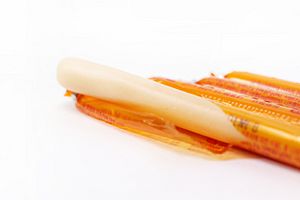Gyoniku soseji facts for kids
Gyoniku soseji (pronounced GYO-nee-koo soh-SEH-jee) is a special type of sausage from Japan. It's made from fish, specifically a paste called surimi. You'll often find it sold in a plastic wrapper, ready to eat as a quick snack.
Gyoniku soseji is a lot like another traditional Japanese fish food called kamaboko, which is a type of fish cake. Both of these fish products are very popular in Japan.
Contents
How Gyoniku Soseji is Made
Making fish sausage on a large scale began in the 1950s. This was a clever way to use up extra fish, especially a type called Alaska pollock. Today, many different kinds of fish can be used to make these sausages.
The sausages might also contain other ingredients like animal fat, gelatin, and wheat. They can also have potato starch, salt, and special ingredients to help them last longer or give them color. The fish paste is put into a plastic casing, often with a distinct orange-red color. This color helps protect the sausage from sunlight. After being sealed, the sausages are boiled in hot water for about 50 minutes. They can then be kept at room temperature for up to two weeks.
What Fish and Meats Are Used?
Common fish used to make gyoniku soseji include marlin and yellowfin tuna. Other fish like bigeye tuna, pollock, and mackerel can also be used. Sometimes, even shark, whale, or squid are included.
It's not just fish! Other meats like pork, mutton, and chicken can also be used. All these meats and fish are first processed into a paste called surimi before being made into the sausage.
The Story of Gyoniku Soseji
The idea of making fish sausage in factories really took off in the 1950s. It was a new way to use a lot of fish, especially Alaska pollock, which was plentiful. This also allowed for using many different kinds of fish and other meats.
The first company to make gyoniku soseji on a big scale was Seinan Kaihatsu Co., Ltd., starting in 1951. Production of fish sausage in Japan reached its highest point in 1965, with 180,000 metric tons made! Since then, the amount produced has gone down a bit, but it has stayed steady at around 60,000-70,000 metric tons each year since the 1990s.
Gyoniku soseji also became popular in Korea. It was first brought there in 1943 for Japanese people living there. Then, starting in 1963, a company called Jin Ju Ham began making it in large amounts. It became a popular addition to children's lunchboxes, known as dosirak, in the 1980s. Later, another company, CJ Foods, started selling smaller versions as snacks. They even added ingredients like corn, cheese, and other healthy things to their 'Maxbong' brand.
How People Use Gyoniku Soseji
People generally think of gyoniku soseji as a healthy snack. It's known for being lower in certain fats. It also became a good alternative source of protein when concerns about a cattle disease made beef supply uncertain. During the 2011 Tōhoku earthquake and tsunami, these sausages were very helpful as emergency food.
Even though it's often eaten as a snack, gyoniku soseji is also used in cooking. You can use it instead of other types of sausage. It's often added to soups, noodle dishes, or even deep-fried.
In Korea, bigger fish sausages are often sliced and pan-fried with an egg batter. They are then eaten as part of a meal or as a side dish called banchan.


